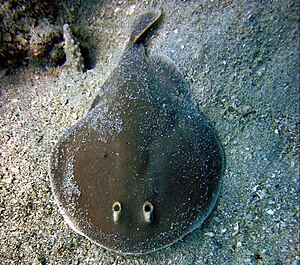Temera hardwickii
| Temera hardwickii | ||||||||||||
|---|---|---|---|---|---|---|---|---|---|---|---|---|

Temera hardwickii |
||||||||||||
| Systematics | ||||||||||||
|
||||||||||||
| Scientific name of the genus | ||||||||||||
| Temera | ||||||||||||
| Gray , 1831 | ||||||||||||
| Scientific name of the species | ||||||||||||
| Temera hardwickii | ||||||||||||
| Gray, 1831 |
Temera hardwickii is a very small ray from the family of sleeper rays(Narkidae). He lives in the Andaman Sea in the northeast of the Indian Ocean and on the coasts of the Malay Peninsula , Thailand, Cambodia and the extreme south of Vietnam. The British zoologist John Edward Gray , author of the first description , named the species after Thomas Hardwicke , whoprocuredthe type specimens .
features
Temera hardwickii is probably only 15 centimeters long, making it the smallest ray and the smallest cartilaginous fish in the world. There are also reports of specimens up to 48 cm long, which are based on confusion with other ray species. The body disc is almost circular, the tail is very short compared to the length of the body disc. It is flat, has a broad base and tapers sharply towards the end. The caudal fin is round to triangular with a sloping upper edge and a flat lower edge. The small, slightly protruding eyes and the round, slightly larger injection holes are close together. The nostrils are round, the nasal curtains are short. The Clasper the males are short, slim and flat. They reach over the rear edge of the pelvic fins. On the back side, the fish are brownish in color, sometimes with individual darker stripes, which however never form a clear pattern. The ventral side of Temera hardwickii is cream-colored, its edges are light brown or gray. Like almost all electric rays Temera hardwickii has bean-shaped, paired electrical organs in the front and middle trunk area. They are visible from the outside on the belly side.
Temera hardwickii is the only type of electric rays that has no dorsal fins and can therefore be easily distinguished from other sleeper rays and electric rays. Temera hardwickii also differs from the also very small and in the same area occurring sleeper ray species Narke dipterygia by the rounder body disc and the different morphology of the mouth and nostrils.
Way of life
Very little is known about the behavior and way of life of Temera hardwickii . The fish live near the coast on soft bottoms and feed on small, bottom-dwelling invertebrates . Four pups were found in a pregnant female. Males become sexually mature with a length of 8 to 10 cm.
Individual evidence
- ↑ a b c d Last, PR, White, WT, Carvalho, MR, Séret, B., Stehmann, M. & Naylor, GJP: Rays of the World. CSIRO Publishing, Melbourne, ISBN 9780643109131 , p. 180.
- ↑ Temera hardwickii on Fishbase.org (English)
Web links
- Temera hardwickii on Fishbase.org (English)

